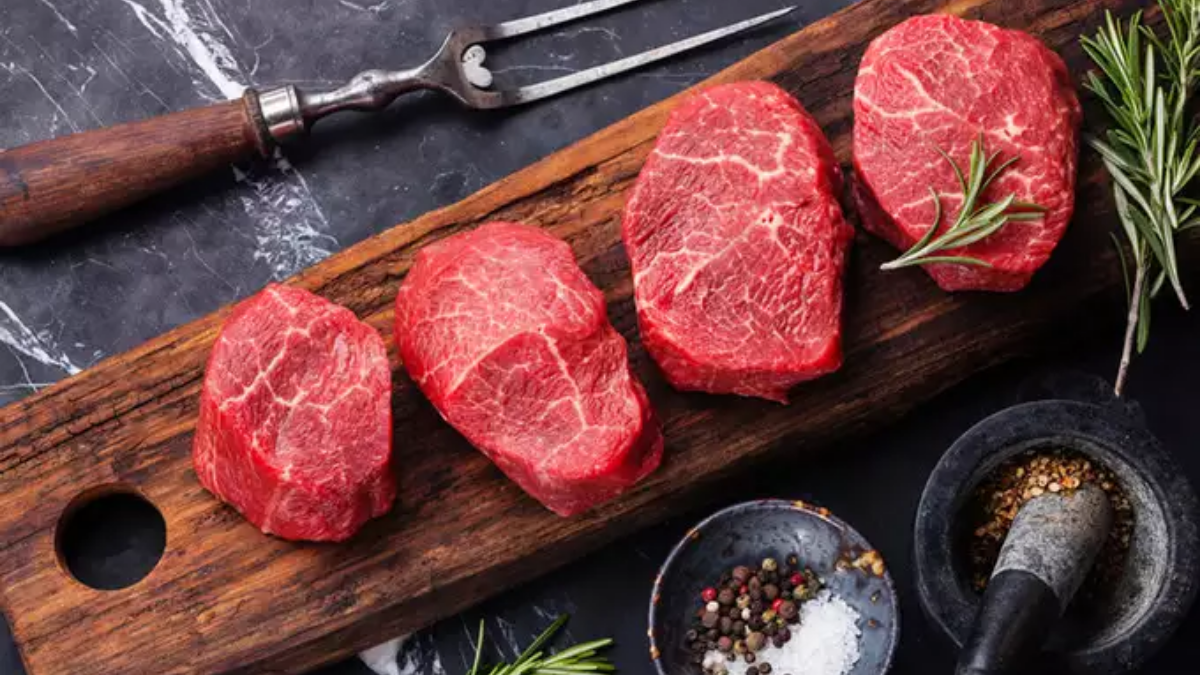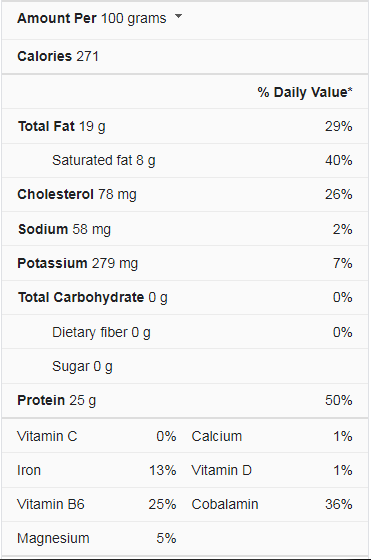Quick-cooking and continual attention is essential whether you want a butter-soft fillet steak, a flavor-packed sirloin, or a more cost-effective cut like bavette, rump, or onglet. Timing is crucial because the difference between rare and well-done is only a few minutes. We’ve put together some pointers to assist you from beginning to end.
Steak Nutrition Facts
What Is Steak?
A steak is a cut of meat that has been sliced across the muscle fibers and may include a bone. It’s usually grilled, although it can also be cooked in a skillet. Steak can also be minced and made into patties, like steak and kidney pie, cooked in sauce and hamburgers. Steaks are frequently sliced from animals, including bison, camel, goat, horse, kangaroo, sheep, ostrich, pigs, reindeer, turkey, deer, zebu, and fish, particularly giant salmon fish like swordfish, shark, and marlin. Chops are used to describe certain kinds of meat, such as pork, lamb and mutton, chevon, and veal. Steak is a common way to prepare cured meats like gammon.
Tips For Cooking Stovetop Steak
Here are some best tips for cooking stovetop steak:
- To begin, thoroughly dry the steak using paper towels. (Any moisture on the steak’s exterior must first evaporate before it starts to brown.)
- Season the steaks with salt and pepper on both sides; the seasoning will attach to the surface and aid in creating a lovely crust.
- Please turn on your exhaust fan and heat a heavy skillet over medium-high heat until it’s smoking. Stainless steel or cast-iron pans are ideal for pan-searing because they resist high heat.
- Toss in the oil in the pan. When it starts to shimmer and move freely about the pan, you know it’s hot enough.
- Set the steak in the pan with care, releasing it away from you so that the oil does not spatter in your face. It ought to be sizzling.
- Add one tablespoon of butter and a couple of sprigs of fresh thyme to the pan with the steaks during the last minute of cooking (this is optional but delicious).
- Look for a steak at least one and a half inches thick when cooking on the stovetop. For stovetop cooking, a thicker cut is preferable. More marbling, or white fat flowing through the meat, is present.
- A butcher should also be able to cut thicker cuts for you. A steak that is too thin will become dry and chewy, and a thinner slice won’t be as tender and juicy.
Transfer the steaks to plates and serve hot if you’re serving them unsliced. If you’re going to slice the steaks, place them on a cutting board and set them aside for 5 to 10 minutes, covered in aluminum foil. Then slice thinly against the grain.
Is Steak Healthy For You?
Here are some health benefits of cooking steak:
Steak is one of the best protein-rich foods
Protein is essential for nearly every cell in your body, and steak is one of the best protein sources. It’s a macronutrient, which means that your body requires a lot of it to function correctly. Protein is necessary for the health of our hair, nails, skin, bones, cartilage, and blood. It’s a necessary component for gaining muscle mass, healing tissues and producing hormones, enzymes, and other compounds in the human body.
Steak can help to prevent iron deficiency
Iron is essential for our bodies; it aids the delivery of oxygen to our cells through our red blood cells, making it essential for daily functioning. Steak is one of the best iron suppliers, making it an excellent dish for people prone to anemia. Not only is red meat high in iron, but it is also more accessible for the body to absorb. One serving of beef provides 15% of our recommended daily iron consumption, which ranges from 13.7 to 15.1 milligrams per day.
Steak is also rich in other essential micronutrients
Apart from protein and iron, steak is high in other nutrients that our bodies require, such as carnosine and creatine, which support the function of our muscles and brains. Those who don’t consume meat have been demonstrated to be deficient in these nutrients in the past.
Steak can improve your smile
As if we needed any more convincing that steak is a healthy dinner option, it turns out that it can even safeguard our bright grins. Steak, believe it or not, is beneficial to dental health. Red meat-eating is encouraged by medical organizations such as the American Dental Association because it is high in phosphorus, which helps to protect bone and tooth enamel.
Steak is good for mental health
This one is particularly intriguing because it appears that red meat may be pretty advantageous to our mental health. Several researchers have found a link between red meat consumption and a lower incidence of mental health issues. In one investigation, scientists discovered 60 women with major depressive illness and 80 with anxiety disorders.
Is Steak Good For Losing Weight?
Steak could be a crucial — and delectable — component of your weight-loss lunches, dinners, and other meals if you’re interested in eating a high-protein diet to lose weight. But don’t make the mistake of believing that you should exclusively consume meat. According to Healthy South Dakota, A high-protein diet can increase your protein intake from 10 to 15 percent of daily calories to 30 to 50 percent of daily calories. Even if you eat a lot of lean cuts of steak, there’s still room for a lot of other low-fat, moderate-carbohydrate foods, according to the agency’s definition of the healthiest way to consume a high-protein diet.
Conclusion
The best steak for stovetop cooking is between one and a half inches thick. A steak that is between this thickness is ideal for stovetop cooking. It should have a lot of marbling on both sides, which gives it a rich, meaty flavor. You can have a butcher cut the steak to the desired thickness and cook it in this way. It is also essential to make sure that the steak is evenly seasoned with salt and pepper.



